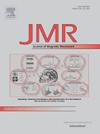非极性溶剂对高磁场下动态核极化的影响
IF 1.9
3区 化学
Q3 BIOCHEMICAL RESEARCH METHODS
引用次数: 0
摘要
液体中的动态核极化(DNP)可以在大于9.4 t的磁场下将核磁共振信号增强两个数量级。DNP实验依赖于通过微波照射样品来驱动电子自旋跃迁,这需要溶剂/样品对微波透明。描述自旋极化转移的物理模型忽略了溶剂的作用,尽管最近的实验结果表明,它对DNP效率的影响可能多达三倍。在本研究中,我们的目的是阐明溶剂如何以及为什么会影响高磁场下的DNP实验。我们研究了分散在CCl4、庚烷和苯中的已知体系(13C-CCl4/TEMPO和PPh3/BDPA)。通过测量它们的EPR特性,模拟微波传播模式,并定量评估在14.1 T下DNP的增强,我们确定非极性溶剂的选择对DNP实验的结果并不重要。此外,我们的实验结果和电磁模拟使我们能够评估DNP仪器在高磁场下的最先进能力,并为未来可能的改进提出方向。本文章由计算机程序翻译,如有差异,请以英文原文为准。

Impact of non-polar solvents in dynamic nuclear polarization at high magnetic fields
Dynamic nuclear polarization (DNP) in liquids can enhance NMR signals by up to two orders of magnitude at magnetic fields greater than 9.4 T. The DNP experiment relies on driving electron spin transitions through microwave irradiation of the sample, which requires the solvent/sample to be transparent to microwaves. The physical models describing spin polarization transfer neglect the role of the solvent, despite recent experimental results suggesting that its impact on DNP efficiency can be as much as a factor of three. In this study, we aim to clarify how and why the solvent may affect DNP experiments at high magnetic fields. We examined known systems (13C-CCl4/TEMPO and PPh3/BDPA) dispersed in CCl4, heptane, and benzene. By measuring their EPR properties, simulating microwave propagation patterns, and quantitatively assessing the DNP enhancements at 14.1 T, we determined that the choice of non-polar solvent is not critical to the outcome of a DNP experiment. Furthermore, our experimental results and electromagnetic simulations enable us to assess the state-of-the-art capabilities of DNP instruments at high magnetic fields and propose directions for possible future improvements.
求助全文
通过发布文献求助,成功后即可免费获取论文全文。
去求助
来源期刊
CiteScore
3.80
自引率
13.60%
发文量
150
审稿时长
69 days
期刊介绍:
The Journal of Magnetic Resonance presents original technical and scientific papers in all aspects of magnetic resonance, including nuclear magnetic resonance spectroscopy (NMR) of solids and liquids, electron spin/paramagnetic resonance (EPR), in vivo magnetic resonance imaging (MRI) and spectroscopy (MRS), nuclear quadrupole resonance (NQR) and magnetic resonance phenomena at nearly zero fields or in combination with optics. The Journal''s main aims include deepening the physical principles underlying all these spectroscopies, publishing significant theoretical and experimental results leading to spectral and spatial progress in these areas, and opening new MR-based applications in chemistry, biology and medicine. The Journal also seeks descriptions of novel apparatuses, new experimental protocols, and new procedures of data analysis and interpretation - including computational and quantum-mechanical methods - capable of advancing MR spectroscopy and imaging.

 求助内容:
求助内容: 应助结果提醒方式:
应助结果提醒方式:


